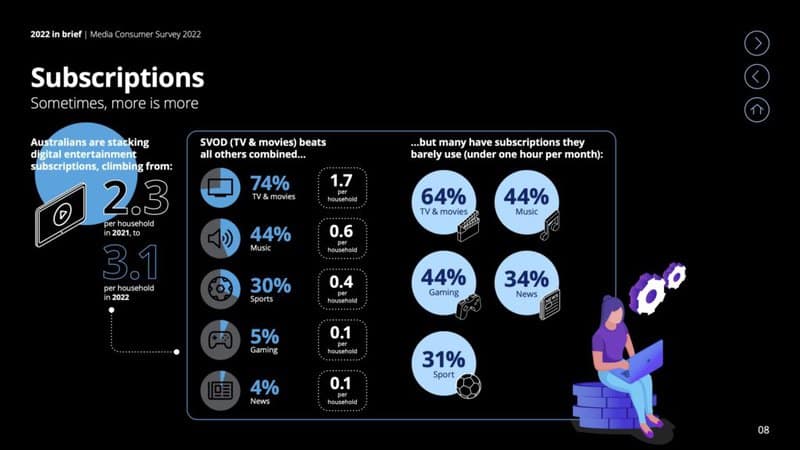Deloitte has revealed its new research that shows Australian consumers would choose to keep their digital media subscription services rather than cut from their budget.
The report surveyed 2000 people and found that spending money on eating out, alcohol and tobacco, and groceries would be cut first over spending on digital entertainment.
Per household, Australians now have 3.1 digital media subscriptions, compared to last year’s 2.3. Most subscriptions are for TV & movie services at 74%, music at 44%, sports at 30%, gaming at 5% and news at 4%.
It also found that monthly spending on digital entertainment rose to $62 in 2022, up from $55 last year. As a result, 64% of those surveyed were reported to be concerned about the cost of multiple subscriptions.

The biggest spenders were Gen Z, with an average spend of $82. Meanwhile, Boomers spend $44 on average.
The report also noted the potential impact of ad-based tiers on subscription services in the future.
Deloitte’s report said: “If ad-based tiers do go mainstream and become a material revenue stream for SVOD providers in the future, they’ll need to rethink their engagement strategy with consumers given those tiers would likely further diminish their relationship strength.”
Peter Corbett, Deloitte partner and national consulting leader for the tech, media and telco industry group, told The Australian Financial Review that he wasn’t surprised to see the number of subscriptions increase.
“We are as a population continuing to stack up subscriptions, and the last year showed that households, on average, have added an extra subscription,” he said.

Corbett noted that the research found Australian consumers saw digital media subscriptions that could not be easily cut out from their budget, but that a subscriptions cost and value influences its place in their budget.
“Australians do value the content they’re receiving and for the subscription media they do sign up for it’s a part of their lives,” he said.
“We’re seeing that 31 per cent of respondents cancelled at least one subscription in the past six months. That is similar to numbers that we’ve seen in previous reports,” Corbett added.
